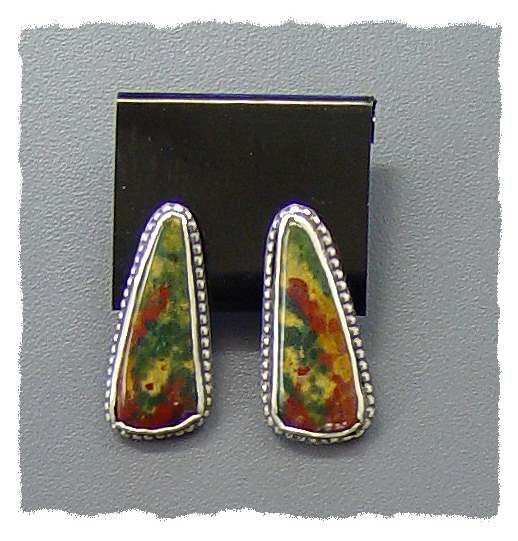Heliotrope Earrings

Although this gorgeous heliotrope is unusually colorful, normally it is dark green with a few "drops" of red so it's easy to understand why is also called "bloodstone."
Having established why heliotrope is called bloodstone, inquiring minds also need to know why bloodstone would be called heliotrope. The Book of Stones says the reason is not known. Apparently the authors have not read Pliny the Elder, or perhaps they have and had the same trouble following his logic that I did. Let's start at the beginning with the etymology: the word heliotrope means "sun turning." Botanically, it refers to any plant that turns toward the sun as does the purple-flowered Heliotropium arborescens. This plant gave "heliotrope" the meaning of "purple." Gary Trudeau once described Zonker as "heliotropic" (no, he isn't purple, he's a cartoon character who used to work on his suntan a lot). Perhaps you've seen or heard of tulips "bowing" before a sadhu but that is likely a bit of stage magic rather than heliotropism Shah says, accomplished with chloroform. At a more elevated level of discussion, Aurelio Porcelaga uses the heliotrope's relation to the sun as an example of how we should relate to God. The name heliotrope was also applied to a surveying instrument invented by Gauss which used focused sunlight. All very interesting, but how can bloodstone be thought of as "sun turning"? After combing Wicca texts, the Catalogue of the Engraved Gems and Rings in the Collection of Joseph Mayer, 1879, an old Grolier's Academic American Encyclopedia and a whole lot of other peculiar works, I finally found the original reference to heliotrope in Pliny's Natural History, book 37, chapter 60:
| "Heliotropium is found in Æthiopia, Africa, and Cyprus: it is of a leek-green colour, streaked with blood-red veins. It has been thus named, from the circumstance that, if placed in a vessel of water and exposed to the full light of the sun, it changes to a reflected colour like that of blood; this being the case with the stone of Æthiopia more particularly. Out of the water, too, it reflects the figure of the sun like a mirror, and it discovers eclipses of that luminary by showing the moon passing over its disk. In the use of this stone, also, we have a most glaring illustration of the impudent effrontery of the adepts in magic, for they say that, if it is combined with the plant heliotropium, and certain incantations are then repeated over it, it will render the person invisible who carries it about him." |
There's a little leap in his logic I can't seem to follow. Is he suggesting that heliotrope plants turn toward the sun; the heliotrope stone, when turned toward the sun, behaves oddly? Or perhaps: the rays of the sun cause the plant to bend, and the stone "bends" the rays of the sun into a different color? That's a stretch but I was working on the "bending" idea because I'm not so quick to dismiss the invisibility option that Pliny seems so testy about. In fact, the current work on invisibility depends upon bending light around the object. Check out the article "Closer to Vanishing: Bending light as a step toward invisibility cloaks" in Science News here. BTW, this text in Pliny was well known to Boccaccio and the ideas are used in the Decameron. (2015 update: If you are interested in the current unacknowledged state of invisibility technology, consider the work of Richard Schowengerdt which likely led to the invisible midgets described in Chameleo by Robert Guffey (below): "A strange but true story of invisible spies, heroin addiction, and Homeland Security." It's a crazy ride, you have been warned!)
Won't you order these pretty earrings and perhaps wear them with some flowers in your hair? Who knows what might happen?


